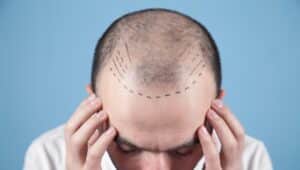Why are some hair transplant unsuccessful? As exciting as getting a hair transplant is, the truth is that it’s not 100% guaranteed that everything will go as planned. People don’t discuss failed hair transplants as much as successful ones, but they happen occasionally. In this article, we’ll discuss why hair transplants fail and cover essential things you must do to ensure the success of your operation.
How Likely Is It for a Hair Transplant To Fail?
The chances of an unsuccessful hair transplant are around 43%, according to an ISHRS study. This study, however, analyses failure based on the patient’s satisfaction and whether hair transplant patients get their expected results. True hair transplant surgery failure is when the transplanted hair follicles fail to grow.
Professional clinics with skilled surgeons usually have a failure rate of less than 2%. Unprofessional clinics, on the other hand, may have up to a 30% failure rate.
Why Do Hair Transplants Fail?

Here are the three most likely reasons:
Inexperienced Surgeon
Some hair transplant surgeons are better skilled in one form of hair transplant than another. For instance, not all surgeons can perform afro hair transplants successfully. Also, most surgeons are only good at Follicular Unit Extraction techniques, and would likely fail at performing transplants with advanced techniques like the DHI.
Poor Post-Surgery Care
Even after a top-class surgeon has done his part, a hair transplant will still be unsuccessful if the patient isn’t given the necessary post-operation care. Poor post-surgery care will negatively impact the hair transplant result. Dressing the wounds, washing the hair, and applying medication are just a few of the many things a recently-operated hair loss patient should enjoy.
Hair transplant patients also have their part to play in ensuring the transplanted hair doesn’t fail to grow as planned. A good clinic will educate you on the dos and don’ts of a post-surgery lifestyle.
Hair Graft Rejection
Hair graft rejection is rare, but it occurs in some patients. Rejected hair implants will not grow. A disease called LLP (Lichen Planopilaris), which causes the inflammation of the upper part of the hair follicles is usually responsible for rejection.
How Bald Is Too Bald for a Hair Transplant?
Generally, a Norwood scale 7 hair loss patient is considered ineligible for a hair transplant. It all comes down to the availability of hairs in the donor area. If the amount of hair follicles in the donor site (usually the nape of the neck) is sparse, or the hair follicles are too thin, the hair transplant operation may be unsuccessful.
However, there have been some successful hair transplant operations involving completely bald patients. So it all comes down to the skill and experience of the surgeon and the hair transplant procedure used.
What Percentage of Hair Transplants Are Successful?
The success of a hair transplant is measured by the percentage of transplanted hair that grows back. A transplant is termed successful if the percentage is 80% or higher. The general success rate of hair transplants is 95 – 98%, especially when using the Follicular Unit Extraction (FUE) technique. Top-rated hair transplant surgeons usually have a close to 100% success rate.
How Can I Make My Hair Transplant Successful?

Choose the Best Clinic
Every highly-reputed hair transplant clinic ensures they give patients the best treatments, as their reputation is on the line. These clinics are also well-versed in advanced techniques like the Sapphire DHI method, which increase the success rate of hair transplants. It’s your duty to find out the hard facts about your desired surgeon/clinic and to know what hair transplant methods they use.
Know Your Eligibility
Most hair loss patients don’t know that certain criteria can make them ineligible for hair transplants. If you have insufficient donor hair or any blood-borne illness, you are not eligible for a hair transplant and it will probably be unsuccessful. Even if you somehow bypass these things and get a transplant, you may end up with terrible results. In situations like these, you should seek a different hair restoration method.
Follow Post-Surgery Instructions
Most hair transplant failures aren’t the surgeon’s fault but the patient’s. If you fail to follow every given post operative instructions, you’ll most likely end up with a failed hair restoration surgery. From diet to haircare and sleeping position, everything can impact your final results.
What Does a Failed Hair Transplant Look Like?
A failed hair transplant is one that doesn’t yield the expected results. So if you wanted to cover your bald head, a failed transplant would leave you with a sparsely covered scalp or transplanted hairs that do not grow at all.
However, the degree of failure varies. For some patients, the hair transplant was successful, but the result didn’t meet their expectations. For some others, the hair transplant was unsuccessful.
A completely failed hair transplant is one where more than 30% of the transplanted grafts do not survive. These cases will typically look like you have grass on your head.
What Are the Rules After a Hair Transplant?
Sometimes, the answer to the question, “Why do hair transplants fail?” is simply the patient’s carelessness. Here are some basic rules every patient must follow after undergoing a hair transplant in Turkey, especially during the first few weeks post-surgery:
- Avoid friction to your head (don’t wear caps or head warmers)
- Avoid alcohol completely
- Avoid any strenuous activity or exercise
- Avoid excess sun exposure
- Avoid extremely hot or cold showers
- Eat a balanced diet
- Wash your head exactly as instructed by your surgeon
Frequently Asked Questions
In the case a hair transplant fails, you can opt for a second transplant, preferably with another surgeon who uses a more advanced hair transplant procedure. If you find out that you are ineligible for a second transplant, you can try other types of hair restoration methods like low-level laser therapy or Platelet-Rich Plasma (PRP) therapy.
If these methods still don’t work out, you may opt for wigs or micro-pigmentation to conceal your hair loss condition.
Hair transplants are permanent. Most transplants will last at least 20 years and, in best cases, for life. However, the newly transplanted hair will fall off about three weeks after surgery; this is part of the growth process. New hairs will typically begin to grow about three months after the transplant and continue for life.




